
Wine Culture and Information since 2002 - Volume 22
 Wine Culture and Information since 2002 - Volume 22 |
|
Wine Tasting, Taste and StandardizationEvery era and every time had its own standards of wine making quality, an evolutionary and enological journey which underwent deep changes |
|
Taste for wine and beverages, likewise, for arts, culture and every other expression associated to the intimate feelings of man, undergoes continuous changes with time and develops according to social and cultural contexts of every place of the world. Wine has been no exception to this rule and, in the course of its millenary history, it changed according to the cultural development of taste. Applied to wine, taste and enological technology have mutually supported one to each other. Without discussing the factors associated to the form of use of wine making technology, it is undeniable it has contributed, for many aspects, to the improvement of the finished product, while affecting - in many aspects - the evolution of taste. Likewise, traditional practices and their form of use, have influenced the development of taste, also at an intellectual and sentimental level. It is not however the case to define what is the “real” taste of wine and what is the best enological technique for making wine: in both cases this would be a show off of intellectual arrogance: in all cases should be considered the ancient saying de gustibus non est disputandum (there is no dispute about taste). If it is certainly wished, the existence of different taste, ideas and opinions, it certainly is unacceptable when they are imposed on others by defining them as absolute, best and indisputable. While noticing difference is always an invaluable richness and an endless resource for everyone, it is however undeniable that, in tastes as well as in opinions, there is a certain “agreeability”, determined on a statistical basis according to an expressed majority, and which tends to define a reference model. These reference models are strongly determined by cultural, historical, traditional and psychological contexts in which are being defined and definable. Likewise, also the concept of wine making quality is affected by the same factors, as well as by facts of ethic and moral type. In this sense, it is the ethics and morality of a producer to set the border between quality and productive and viticultural compromise. Every production and cultivation technique has the effect of determining the organoleptic profile of a wine, both in positive as well as in negative terms. The adoption of every technique is based on the moral and ethic orientation of every producer, as well as - of course - the personal opinion or prejudice about the technique itself. The same orientation, in the definition of quality and taste, is therefore adopted by consumers, each of them having personal references and preferences.
The reference for taste and enological quality is therefore strongly influenced by this type of choice, prejudices and orientations. In order to give an example, the use of selected yeast - having the capability of strongly orienting the organoleptic profile of a wine, just like the so called indigenous yeast - can be a prejudicial element in the evaluation of wine quality. Tasters and consumers openly contrary to selected yeast will tend to penalize, or to not prefer at all, those wines produced with this technique, whereas it is very likely they tend to recognize of higher quality the wines in which they are not used. Likewise, wines produced with a fermentation done by indigenous yeast, could be penalized and not favored by those who like the typical aromas of selected yeast. For the sake of clearness and completeness, it should be noticed every yeast - either selected or indigenous - has in any case the capability of orienting the organoleptic profile of a wine. it is not by chance the so called “secondary aromas” of a wine are also defined as “aromas of fermentation”, just to emphasize the fundamental role of yeast, of any type, in the formation of the olfactory profile of a wine. Moreover, it is said that primary aromas of the grape are revealed by fermentation, that is by yeast, which, unavoidably, will add to the aromas of the grape its aromas as well. Finally, it should be always noticed the selection of yeast, and therefore the control of the organoleptic qualities of a wine at the end of fermentation, can be done by controlling temperature. This concept is true both for selected and indigenous yeast, that, by controlling temperature, as well as by using sulphur dioxide, undergo a radical biological change, by inhibiting or favoring the activity of specific species. Sensorial tasting of a wine, despite it should be done objectively and according to reference quality criteria, it is undeniable it is frequently affected by personal and subjective predispositions and tastes. This condition, of course not negligible, is however capable of orienting the definition both of wine quality as well as of taste. Factors which are not only determined by prejudicial reasons towards certain styles or wine making techniques, but also by the influence of fashions or imposed quality references. For example, something which can be adapted to any other productive or stylistic factor, we could think about the barrique fashion and how every wine fermented or aged in the small Bordelais barrel could easily meet the favor and the appreciation of both critics and consumers. In less than twenty years, the feelings about barrique have radically changed, as to be rejected as well as the wines produced with this wine making tool, even in case it was used judiciously and without abusing of it. The references for sensorial tasting, and with that, also technique, have changed in the course of the history of wine. As new fashions and tastes were introduced, the references and the techniques used for tasting a wine changed as well. In this sense, a huge help has been contributed by the research done from the beginning of the 1900s, which contributed to improve the understanding of what is a wine, also from a chemical and biological point of view. Research has in fact allowed a more rigorous definition of sensorial tasting methods, by allowing it to abandon, for certain aspects, the empirical methods - based on simple, however important, observations - therefore allowing the understanding of the interaction among each gustatory and tactile stimuli in the physiology of taste. Of course, we are not going to state in the past they were not capable of tasting a wine, but it is however undeniable the result of researches and studies have allowed the improvement both of technique and understanding. A process concerning every phenomenon about knowledge and the perception of the world in which we live in: we could think, for example, that before the extraordinary intuitions of Galileo Galilei, the world was considered to be the center of a system in which the sun was revolving around it. Likewise, today we know that, for example, effervescence in sparkling wines is produced by carbon dioxide, as well as we know that ethyl alcohol is produced by yeast by converting sugar. A better understanding of the phenomena involved in the production of wine and its evolution over time, has therefore been fundamental for the understanding of sensorial and organoleptic tasting. This also brought to the mutual influence of the two disciplines: production of wine is frequently made according to the criteria of sensorial tasting in order to meet specific parameters. The same influence is given, maybe in a more substantial way, by fashions and trends of consumption; not only in order to satisfy simple marketing needs, therefore ensuring a better profit, but also in order to conform to specific wine making styles. If we observe the last twenty years of wine production, in particular, the references of quality set both by critics and consumers, the latter frequently influenced by critics themselves, they have strongly determined wine production. Fashions coming and going, most of the times repeating after some years, unavoidably set new reference criteria also altering the sensorial evaluation of a wine. In fact, it should be said, it is inappropriate to set an absolute reference for wine quality, just because it is mainly expressed through senses, therefore, in continuous evolution and determined by subjective and cultural factors of every period. The history of wine is the witness of how much fashions and trends of every time are destined to born, grow up and, finally, to disappear, therefore coming back to a new life, even denying their decay. We have in fact seen the era of white wines, followed by the one of red wines, the return of white wines and then of reds, in a virtually endless chasing which does not seem to end. Likewise, if today the so called natural wines are having an undeniable moment of notoriety - while noticing up to few years ago they were considered in a truly different way - they will unavoidably be destined to a lower appreciation as soon as a new fashion will enter the world of wine. It should be said fashions - all fashions, including those concerning wine - born, live, develop and then are destined to an unavoidable decay in specific social and cultural contexts, also defining strict criteria for sensorial evaluation, strongly affected by factors considered as absolute however not always accepted by other as such. The concrete risk which may happen in these case is the definition of a standardization of taste, something happening not only for wine, as all styles and production techniques - with no exception - tend to give the wine recognizable and identifying organoleptic qualities. Technological wines are clearly recognizable since the very beginning of tasting, likewise, wines belonging to an artisan production style can be easily recognized as such. In fact, it takes a quick observation of the glass, as well as a quick evaluation of aromas in order to understand - even superficially - the productive style of every wine. The preference for a specific wine style, a legitimate choice and behavior, of course, is a serious risk for the taster, as this will make the taster judge certain wines better than others, because they belong to his or her favorite style, by excluding the others prejudicially, also in case they are produced with an acceptable quality. Standardization in fact represents for the taster one of the worst pitfalls for the reliability of his or her job. While it should be recognized to fashions and trends of every time a fundamental role in the formation of a reference taste in every social and cultural context, this should not influence - in any case - the evaluation of a wine in case its goal is beyond the simple consumption. These are considerations that, of course, do not have any influence in consumers' evaluation of a wine who, legitimately, determine the quality and agreeability of a wine according to their taste and without considering any technical factor. In conclusion, this does not mean consumers' opinion about wine is not reliable or useful: indeed, it contributes to the definition of the wine making model which best reflects the taste of every period and therefore it should be carefully considered.
|
||||||||||||
Wines of the Month |
|
|
|
Score legend Prices are to be considered as indicative. Prices may vary according to the country or the shop where wines are bought |
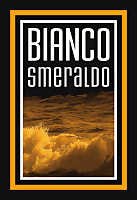
|
|
Vermentino di Gallura Bianco Smeraldo 2010 |
|
| Un Mare Di Vino (Sardinia, Italy) | |
| Grapes: Vermentino | |
| Price: € 14.50 | Score: |
| Vermentino di Gallura Bianco Smeraldo shows an intense greenish yellow color and nuances of greenish yellow, very transparent. The nose denotes intense, clean, pleasing and refined aromas that start with hints of pear, apple and peach followed by aromas of plum, hawthorn, pineapple, broom, lemon and almond. The mouth has good correspondence to the nose, a crisp attack and however balanced by alcohol, good body, intense flavors, agreeable. The finish is persistent with flavors of pear, peach and almond. Vermentino di Gallura Bianco Smeraldo ages in steel tanks. | |
| Food Match: Fried fish, Risotto and pasta with crustaceans and fish, Sauteed fish, Dairy products | |

|
|
Oltremare 2010 |
|
| Un Mare Di Vino (Sardinia, Italy) | |
| Grapes: Carignano, Merlot, Cabernet Franc | |
| Price: € 26.00 | Score: |
| Oltremare shows an intense ruby red color and nuances of ruby red, little transparency. The nose reveals intense, clean, pleasing, refined and elegant aromas which start with hints of black cherry, blackberry and plum followed by aromas of blueberry, black currant, violet, vanilla, tobacco, chocolate, mace and menthol. The mouth has good correspondence to the nose, a properly tannic attack and however balanced by alcohol, good body, intense flavors, pleasing roundness. The finish is persistent with flavors of black cherry, blackberry and plum. Oltremare ages for 18 months in cask. | |
| Food Match: Roasted meat, Braised and stewed meat, Broiled meat and barbecue, Hard cheese | |
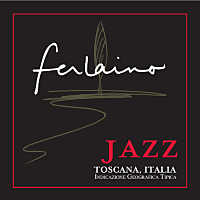
|
|
Jazz 2009 |
|
| Ferlaino (Tuscany, Italy) | |
| Grapes: Sangiovese (37%), Merlot (32%), Cabernet Franc (26%), Petit Verdot (5%) | |
| Price: € 25.50 | Score: |
| Jazz shows an intense ruby red color and nuances of garnet red, little transparency. The nose denotes intense, clean, pleasing and refined aromas which start with hints of black cherry, plum and black currant followed by aromas of violet, blueberry, vanilla, chocolate, mace, bell pepper and eucalyptus. The mouth has good correspondence to the nose, a tannic attack and however balanced by alcohol, good body, intense flavors, agreeable. The finish is persistent with flavors of black cherry, plum and black currant. Jazz ages for 18 months in barrique, 8 months in steel tanks and for at least 8 months in bottle. | |
| Food Match: Roasted meat, Stewed and braised meat with mushrooms, Hard cheese | |

|
|
Tango 2009 |
|
| Ferlaino (Tuscany, Italy) | |
| Grapes: Merlot (58%), Cabernet Franc (25%), Petit Verdot (17%) | |
| Price: € 30.00 | Score: |
| Tango shows an intense ruby red color and nuances of ruby red, little transparency. The nose denotes intense, clean, pleasing and refined aromas which start with hints of black currant, black cherry and plum followed by aromas of blueberry, violet, vanilla, bell pepper, peony, chocolate and eucalyptus. The mouth has good correspondence to the nose, a properly tannic attack and however balanced by alcohol, good body, intense flavors, pleasing roundness. The finish is persistent with flavors of black currant, black cherry and plum. Tango ages for 18 months in barrique followed by 8 months of aging in bottle. | |
| Food Match: Roasted meat, Stewed and braised meat, Hard cheese | |
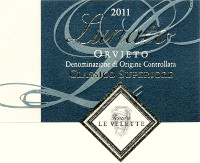
|
|
Orvieto Classico Superiore Lunato 2011 |
|
| Le Velette (Umbria, Italy) | |
| Grapes: Grechetto (40%), Procanico (20%), Malvasia Bianco (20%), Verdello (15%), Drupeggio (5%) | |
| Price: € 6.60 | Score: |
| Orvieto Classico Superiore Lunato shows a pale golden yellow color and nuances of straw yellow, very transparent. The nose denotes intense, clean, pleasing and refined aromas which start with hints of apple, plum and hawthorn followed by aromas of pear, broom, honey, almond, citrus fruits and mineral. The mouth has good correspondence to the nose, a crisp attack and however balanced by alcohol, good body, intense flavors, pleasing roundness. The finish is persistent with flavors of plum, apple and honey. Orvieto Classico Superiore Lunato ages in steel tanks. | |
| Food Match: Stuffed pasta, Roasted white meat, Roasted fish, Stewed fish | |
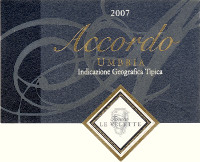
|
|
Accordo 2007 |
|
| Le Velette (Umbria, Italy) | |
| Grapes: Sangiovese | |
| Price: € 8.70 | Score: |
| Accordo shows an intense ruby red color and nuances of garnet red, moderate transparency. The nose denotes intense, clean, pleasing and refined aromas which start with hints of plum, black cherry and violet followed by aromas of blueberry, vanilla, chocolate, tobacco, mace and menthol. The mouth has good correspondence to the nose, a properly tannic attack and however balanced by alcohol, good body, intense flavors, agreeable. The finish is persistent with flavors of black cherry, plum and blueberry. Accordo ages for 12 months in barrique followed by 12 months of aging in bottle. | |
| Food Match: Broiled meat and barbecue, Roasted meat, Stewed meat, Hard cheese | |
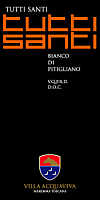
|
|
Tutti Santi 2010 |
|
| Villa Acquaviva (Tuscany, Italy) | |
| Grapes: Trebbiano Toscano, Malvasia Bianca, Verdello | |
| Price: € 12.00 | Score: |
| Tutti Santi shows an intense amber yellow color and nuances of amber yellow, very transparent. The nose denotes intense, clean, pleasing and refined aromas that start with hints of quince, plum and almond followed by aromas of peach jam, hawthorn, honey, citrus fruit peel, raisin, vanilla and nail polish. The mouth has good correspondence to the nose, a crisp attack and round, however balanced by alcohol, good body, intense flavors, pleasing sweet hint. The finish is persistent with flavors of quince, almond and raisin. Tutti Santi is made from late harvested grapes, ages for 12 months in barrique followed by 24 months of aging in bottle. | |
| Food Match: Roasted white meat, Cheese, Roasted fish | |
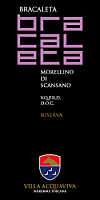
|
|
Morellino di Scansano Riserva Bracaleta 2006 |
|
| Villa Acquaviva (Tuscany, Italy) | |
| Grapes: Sangiovese (85%), Alicante, Malvasia Nera (15%) | |
| Price: € 16.00 | Score: |
| Morellino di Scansano Riserva Bracaleta shows a brilliant ruby red color and nuances of garnet red, moderate transparency. The nose denotes intense, clean, pleasing and refined aromas that start with hints of cherry, plum and dried violet followed by aromas of raspberry, blueberry, dried rose, vanilla, tobacco, cocoa and menthol. The mouth has good correspondence to the nose, a properly tannic attack and however balanced by alcohol, good body, intense flavors, pleasing crispness. The finish is persistent with flavors of cherry, raspberry and plum. Morellino di Scansano Riserva Bracaleta ages in cask. | |
| Food Match: Broiled meat and barbecue, Roasted meat, Stewed meat with mushrooms | |
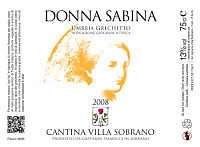
|
|
Donna Sabina 2008 |
|
| Villa Sobrano (Umbria, Italy) | |
| Grapes: Grechetto | |
| Price: € 12.50 | Score: |
| Donna Sabina shows a brilliant straw yellow color and nuances of straw yellow, very transparent. The nose denotes intense, clean, pleasing and refined aromas which start with hints of apple, plum and hazelnut followed by aromas of pear, mature peach, medlar, broom, hawthorn, honey and hints of vanilla. The mouth has good correspondence to the nose, a crisp attack and however balanced by alcohol, good body, intense flavors, pleasing roundness. The finish is persistent with flavors of apple, plum and hazelnut. Donna Sabina ages for 12 months in cask followed by 12 months of aging in bottle. | |
| Food Match: Stuffed pasta, Roasted white meat, Roasted fish, Fish soups | |
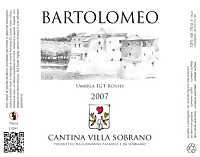
|
|
Bartolomeo 2007 |
|
| Villa Sobrano (Umbria, Italy) | |
| Grapes: Sangiovese (50%), Merlot (50%) | |
| Price: € 13.50 | Score: |
| Bartolomeo shows an intense ruby red color and nuances of garnet red, little transparency. The nose reveals intense, clean, pleasing and refined aromas which start with hints of plum, black currant and black cherry followed by aromas of dried violet, vanilla, tobacco, green bean, chocolate, mace and eucalyptus. The mouth has good correspondence to the nose, a properly tannic attack and however balanced by alcohol, good body, intense flavors, pleasing roundness. The finish is persistent with flavors of black cherry, plum and black currant. Bartolomeo ages in barrique for 14 months followed by 24 months of aging in bottle. | |
| Food Match: Broiled meat and barbecue, Roasted meat, Stewed and braised meat, Hard cheese | |

|
|
Colli di Luni Vermentino Sur Lie 2011 |
|
| Arrigoni (Liguria, Italy) | |
| Grapes: Vermentino | |
| Price: € 16.00 | Score: |
| Colli di Luni Vermentino Sur Lie shows a brilliant straw yellow color and nuances of straw yellow, very transparent. The nose reveals intense, clean, pleasing and refined aromas which start with hints of apple, plum and honey followed by aromas of hawthorn, citrus fruits, broom, almond, pear and mature peach. The mouth has good correspondence to the nose, a crisp attack and a sweet hint, however balanced by alcohol, good body, intense flavors, slight effervescence. The finish is persistent with flavors of apple, plum and pear. Colli di Luni Vermentino Sur Lie ages in cement tanks. | |
| Food Match: Roasted white meat, Roasted fish, Stuffed pasta | |
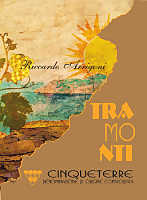
|
|
Cinqueterre Tramonti 2011 |
|
| Arrigoni (Liguria, Italy) | |
| Grapes: Bosco (60%), Albarola, Vermentino (40%) | |
| Price: € 16.00 | Score: |
| Cinqueterre Tramonti shows a pale straw yellow color and nuances of greenish yellow, very transparent. The nose reveals intense, clean, pleasing and refined aromas which start with hints of apple, plum and hawthorn followed by aromas of citrus fruits, broom, almond, pear, fennel, mineral and hints of iodine. The mouth has good correspondence to the nose, a crisp attack and however balanced by alcohol, good body, intense flavors, pleasing roundness. The finish is persistent with flavors of apple, plum and pear. Cinqueterre Tramonti ferments and ages in barrique for 4 months. | |
| Food Match: Stuffed pasta, Roasted white meat, Roasted fish, Stewed fish | |
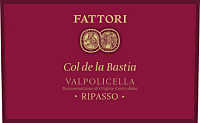
|
|
Valpolicella Ripasso Col de la Bastia 2010 |
|
| Fattori (Veneto, Italy) | |
| Grapes: Corvina (65%), Corvinone (15%), Rondinella (10%), Altre Uve (10%) | |
| Price: € 28.00 | Score: |
| Valpolicella Ripasso Col de la Bastia shows an intense ruby red color and nuances of ruby red, little transparency. The nose denotes intense, clean, pleasing and refined aromas which start with hints of black cherry, blackberry and plum followed by aromas of violet, blueberry, vanilla, tobacco, chocolate, mace and menthol. The mouth has good correspondence to the nose, a properly tannic attack and however balanced by alcohol, good body, intense flavors, pleasing roundness. The finish is persistent with flavors of black cherry, blackberry and plum. Valpolicella Ripasso Col de la Bastia ages in cask. | |
| Food Match: Roasted meat, Stewed and braised meat with mushrooms, Broiled meat and barbecue | |
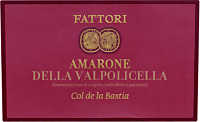
|
|
Amarone della Valpolicella Col de la Bastia 2010 |
|
| Fattori (Veneto, Italy) | |
| Grapes: Corvina (65%), Corvinone (15%), Rondinella (10%), Altre Uve (10%) | |
| Price: € 35.00 | Score: |
| Amarone della Valpolicella Col de la Bastia shows an intense ruby red color and nuances of ruby red, little transparency. The nose reveals intense, clean, pleasing and refined aromas which start with hints of blackberry, plum and black cherry followed by aromas of violet, blueberry, vanilla, tobacco, mace, chocolate and menthol. The mouth has good correspondence to the nose, a tannic attack and however balanced by alcohol, full body, intense flavors, pleasing roundness. The finish is persistent with flavors of blackberry, plum and black cherry. Amarone della Valpolicella Col de la Bastia ages in cask for about 24 months. | |
| Food Match: Game, Roasted meat, Stewed and braised meat, Hard cheese | |
|
||||||||
|
DiWineTaste Polls
|
| |||||||
Privacy Policy | |||||||


| Copyright © 2002-2024 Antonello Biancalana, DiWineTaste - All rights reserved |
| All rights reserved under international copyright conventions. No part of this publication and of this WEB site may be
reproduced or utilized in any form or by any means, electronic or mechanical, without permission in writing from DiWineTaste. |